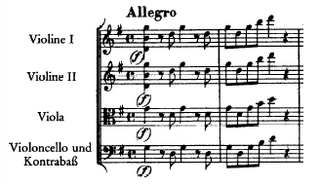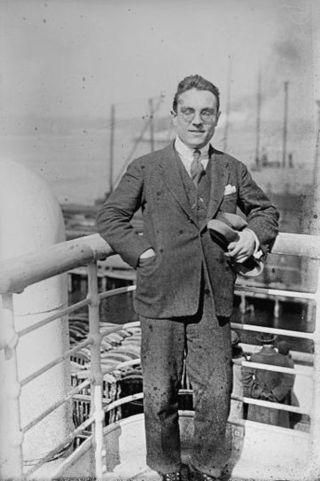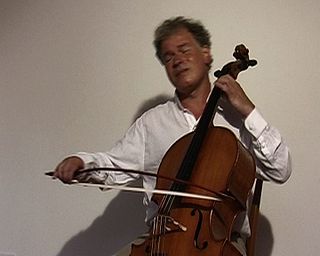
The violoncello ( VY-ə-lən-CHEL-oh, Italian pronunciation:[vjolonˈtʃɛllo]), often simply abbreviated as cello ( CHEL-oh), is a bowed (sometimes plucked and occasionally hit) string instrument of the violin family. Its four strings are usually tuned in perfect fifths: from low to high, C2, G2, D3 and A3. The viola's four strings are each an octave higher. Music for the cello is generally written in the bass clef, with tenor clef, and treble clef used for higher-range passages.

Mstislav Leopoldovich Rostropovich was a Russian cellist and conductor. In addition to his interpretations and technique, he was well known for both inspiring and commissioning new works, which enlarged the cello repertoire more than any cellist before or since. He inspired and premiered over 100 pieces, forming long-standing friendships and artistic partnerships with composers including Dmitri Shostakovich, Sergei Prokofiev, Henri Dutilleux, Witold Lutosławski, Olivier Messiaen, Luciano Berio, Krzysztof Penderecki, Alfred Schnittke, Norbert Moret, Andreas Makris, Leonard Bernstein, Aram Khachaturian, and Benjamin Britten.
In music, a bow is a tensioned stick which has hair coated in rosin affixed to it. It is moved across some part of a musical instrument to cause vibration, which the instrument emits as sound. The vast majority of bows are used with string instruments, such as the violin, viola, cello, and bass, although some bows are used with musical saws and other bowed idiophones.

In music, a double stop is the technique of playing two notes simultaneously on a stringed instrument such as a violin, a viola, a cello, or a double bass. On instruments such as the Hardanger fiddle it is common and often employed. In performing a double stop, two separate strings are bowed or plucked simultaneously. Although the term itself suggests these strings are to be fingered (stopped), in practice one or both strings may be open.

Emil Telmányi was a Hungarian violinist.
The Concerto for Two Violins in D minor, BWV 1043, also known as the Double Violin Concerto, is a violin concerto of the Late Baroque era, which Johann Sebastian Bach composed around 1730. It is one of the composer's most successful works.

The sonatas and partitas for solo violin are a set of six works composed by Johann Sebastian Bach. They are sometimes referred to in English as the sonatas and partias for solo violin in accordance with Bach's headings in the autograph manuscript: "Partia" was commonly used in German-speaking regions during Bach's time, whereas the Italian "partita" was introduced to this set in the 1879 Bach Gesellschaft edition, having become standard by that time. The set consists of three sonatas da chiesa in four movements and three partitas in dance-form movements. The 2nd Partita is widely known for its Chaconne, considered one of the most masterly and expressive works ever written for solo violin.
Daniel Müller-Schott is a German cellist.
Johann Sebastian Bach composed suites, partitas and overtures in the baroque dance suite format for solo instruments such as harpsichord, lute, violin, cello and flute, and for orchestra.
Mikhail Emmanuilovich Goldstein, was a German composer, violinist and violin teacher of German-Jewish origin, brother of prominent violinist Boris Goldstein. His great uncle was the physicist Eugen Goldstein.

Nathan "Tossy" Spivakovsky, a Jewish, Russian Empire-born, German-trained violin virtuoso, was considered one of the greatest violinists of the 20th century.

Andreas Makris was a Greek-American composer and violinist, born in Kilkis, Greece, on March 7, 1930. He was a Composer-in-Residence for many years at the National Symphony Orchestra in Washington DC, working with conductors such as Howard Mitchell, Mstislav Rostropovich, Antal Dorati, and Leonard Slatkin. He composed around 100 works for orchestra, chamber ensembles, and solo instruments, including the Aegean Festival Overture, which, transcribed for concert band by Major Albert Bader of the USAF Band, became a popular piece with US bands. Grants and awards he received include the Damroch Grant, National Endowment for the Arts Grant, the Martha Baird Rockefeller Award, ASCAP Award, the Fulbright Scholarship, and citations from the Greek Government.

Michael Bach, also known as Michael Bach Bachtischa, is a German cellist, composer, and visual artist.

Rudolf Borisovich Barshai was a Soviet and Russian conductor and violist.

The concerto for two harpsichords in C minor, BWV 1060, is a concerto for two harpsichords and string orchestra by Johann Sebastian Bach. It is likely to have originated in the second half of the 1730s as an arrangement of an earlier concerto, also in C minor, for oboe and violin. That conjectural original version of the concerto, which may have been composed in Bach's Köthen years (1717–1723), is lost, but has been reconstructed in several versions known as BWV 1060R.

The six sonatas for violin and obbligato harpsichord BWV 1014–1019 by Johann Sebastian Bach are works in trio sonata form, with the two upper parts in the harpsichord and violin over a bass line supplied by the harpsichord and an optional viola da gamba. Unlike baroque sonatas for solo instrument and continuo, where the realisation of the figured bass was left to the discretion of the performer, the keyboard part in the sonatas was almost entirely specified by Bach. They were probably mostly composed during Bach's final years in Cöthen between 1720 and 1723, before he moved to Leipzig. The extant sources for the collection span the whole of Bach's period in Leipzig, during which time he continued to make changes to the score.

Philippe Borer was a Swiss violinist, scholar and teacher.

Georges Frey was a French violinist, viola player and specialist of the curved bow. He is the father of the pianist and organist Jean-Claude Frey.

Rudolf Gaehler is a German violinist. He uses the curved bow for playing polyphonic music.



















